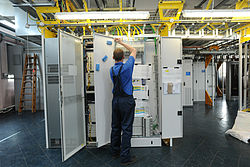The Switch is a telephone network component that connects your phone line with another line to establish a telephone call. Early telephone technology relied on human operators on very large switchboards to provide manual switching services. Current Voice over Internet Protocol (VoIP) technology uses virtual or digital switches to connect phones over the Internet.
This article needs additional citations for verification. (March 2010) (Learn how and when to remove this template message) |


A telephone exchange or telephone switch is a telecommunications system used in the public switched telephone network or in large enterprises. It interconnects telephone subscriber lines or virtual circuits of digital systems to establish telephone calls between subscribers.
In historical perspective, telecommunication terms have been used with different semantics over time. The term telephone exchange is often used synonymously with central office, a Bell System term. Often, a central office is defined as a building used to house the inside plant equipment of potentially several telephone exchanges, each serving a certain geographical area. Such an area has also been referred to as the exchange or exchange area. In North America, a central office location may also be identified as a wire center, designating a facility from which a telephone obtains dial tone. For business and billing purposes, telephony carriers define rate centers, which in larger cities may be clusters of central offices, to define specified geographical locations for determining distance measurements.
In the United States and Canada, the Bell System established in the 1940s a uniform system of identifying central offices with a three-digit central office code, that was used as a prefix to subscriber telephone numbers. All central offices within a larger region, typically aggregated by state, were assigned a common numbering plan area code. With the development of international and transoceanic telephone trunks, especially driven by direct customer dialing, similar efforts of systematic organization of the telephone networks occurred in many countries in the mid-20th century.
For corporate or enterprise use, a private telephone exchange is often referred to as a private branch exchange (PBX), when it has connections to the public switched telephone network. A PBX is installed in enterprise facilities, typically near large office spaces or within an organizational campus to serve the organization's telephones and any private leased line circuits. Smaller installations might deploy a PBX or key telephone system in the office of a receptionist.
